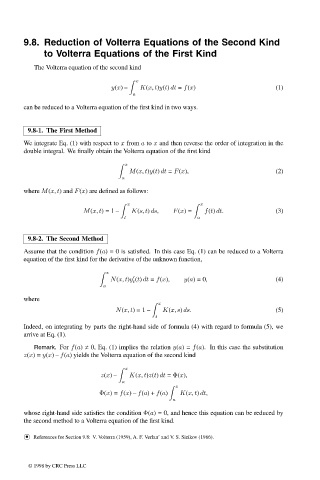Page 503 - Handbook Of Integral Equations
P. 503
9.8. Reduction of Volterra Equations of the Second Kind
to Volterra Equations of the First Kind
The Volterra equation of the second kind
x
y(x) – K(x, t)y(t) dt = f(x) (1)
a
can be reduced to a Volterra equation of the first kind in two ways.
9.8-1. The First Method
We integrate Eq. (1) with respect to x from a to x and then reverse the order of integration in the
double integral. We finally obtain the Volterra equation of the first kind
x
M(x, t)y(t) dt = F(x), (2)
a
where M(x, t) and F(x) are defined as follows:
x x
M(x, t)=1 – K(s, t) ds, F(x)= f(t) dt. (3)
t a
9.8-2. The Second Method
Assume that the condition f(a) = 0 is satisfied. In this case Eq. (1) can be reduced to a Volterra
equation of the first kind for the derivative of the unknown function,
x
N(x, t)y (t) dt = f(x), y(a)=0, (4)
t
a
where
x
N(x, t)=1 – K(x, s) ds. (5)
t
Indeed, on integrating by parts the right-hand side of formula (4) with regard to formula (5), we
arrive at Eq. (1).
Remark. For f(a) ≠ 0, Eq. (1) implies the relation y(a)= f(a). In this case the substitution
z(x)= y(x) – f(a) yields the Volterra equation of the second kind
x
z(x) – K(x, t)z(t) dt = Φ(x),
a
x
Φ(x)= f(x) – f(a)+ f(a) K(x, t) dt,
a
whose right-hand side satisfies the condition Φ(a) = 0, and hence this equation can be reduced by
the second method to a Volterra equation of the first kind.
•
References for Section 9.8: V. Volterra (1959), A. F. Verlan’ and V. S. Sizikov (1986).
© 1998 by CRC Press LLC
© 1998 by CRC Press LLC
Page 485

